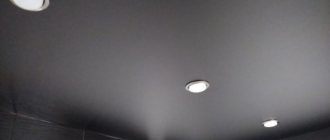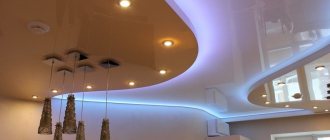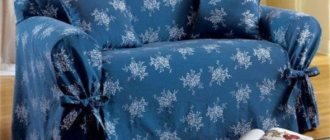Preparing to wash
Cleaning at home is not difficult at all. But stretch fabrics require a gentle attitude. Following these guidelines will allow you to carry out the cleaning procedure with ease.
- Processing is carried out only with soft material: sponge, microfiber, fleece, flannel. The item of choice is microfiber. It has a number of advantages: soft, lightweight, absorbs water well, and collects small particles of dirt.
- Before starting work, you must remove the rings from your fingers - they can scratch the canvas.
How often should suspended ceilings be washed?
It is necessary to wash suspended ceilings at home regularly, as they become dirty.
The reasons for holding this event are as follows:
- Risk of developing allergic reactions. The canvases have a large area that collects dust. From exposure to air currents (when people walk, when making bed linen, during children's games), it separates from the film and settles down, entering the respiratory system.
- Loss of presentability. A gray layer of dust, stains of grease, paint and water spoil the appearance of the tension structure, having a negative impact on the interior of the room. Such details make a bad impression and worsen the perception of the situation.
- Structural deformation. Due to the weight of the contaminants, the canvas gradually sags, losing horizontality. If the layers are not removed in a timely manner, the material will take a new shape, will not be able to straighten and will have to be replaced.
The recommended time intervals for washing tension fabrics are as follows:
- after installation – after 3-4 months;
- on balconies and loggias - every 2-3 months;
- in living rooms - after six months;
- in the bathroom - every 2 weeks;
- in the toilet - every month;
- after renovation of the apartment - 30 days after completion;
- in the kitchen - every 2 months.
If the material is contaminated with food, paint, glue, pen or marker, clean it immediately before the substances dry or crystallize.
These terms are not dogma. You can determine that ceilings need cleaning visually, without waiting for any period of time. The more often the canvas is cleaned, the longer it will last, and the room will constantly maintain a comfortable and cozy environment.
How to wash suspended ceilings
Surfaces are cleaned depending on the degree of contamination. Dust and cobwebs are removed with a slightly damp cloth. Universal cleaning gels and solutions help get rid of stains.
Household pollution is well removed: Mister Muscle, Biolan, Mister Proper, Fairy. They act gently and do not contain aggressive ingredients.
Special detergents, in addition to their cleaning effect, have an antistatic property that prevents dust from sticking again.
In the kitchen, the ceiling gets the most dirty. Even with a hood, greasy fumes, dust, and soot settle on it.
Sprays containing ammonia help to get rid of the misfortune - they dissolve greasy drops. You can use products designed for cleaning windows.
What is prohibited from washing a ceiling product?
- Hot water (can lead to deformation of the material);
- Washing powder (leaves unsightly stains);
- Abrasives;
- Hard brushes;
- Chemicals: acetone, solvents, chlorine-containing products.
How to clean a suspended ceiling with your own hands - step-by-step instructions
This method is universal and safe. Suitable for wet cleaning of PVC products. Useful for cleaning lightly soiled surfaces.
- Prepare a soap solution in a basin or other wide container. It is more convenient to use liquid soap. For 5 liters of warm water, take half a teaspoon of gel.
- Soak a microfiber cloth or sponge in the solution and squeeze so that it does not drip. Place it on the mop and start cleaning. Movements are carried out in the direction from one wall to another, periodically rinsing the rag.
- Heavily contaminated areas are wiped with special products.
- After cleaning, wipe with a dry soft cloth.
If the ceiling is large, it is divided into two halves. In this case, wash starting from the wall to the center.
When washing by hand, without using a mop, it becomes necessary to use a stepladder. They also go over local spots and hard-to-reach places manually.
Important: the washing movements are carried out smoothly and carefully, avoiding strong pressure on the canvas. This will prevent dirt from rubbing in and damaging the material.
How and what to wash?
How to wash a suspended ceiling? Before the process of washing the ceilings, you must have the following materials with you:
- Soft tissues and sponges. Using hard and hard brushes will only damage the stretch ceiling.
- Light mops.
- A basin or bucket of water.
- Dishes.
- Window cleaning products.
- All kinds of alcohol-based products.
- Soap solution.
You will need a bowl of water to dilute the dishwashing detergent in it. This mixture will remove all stains of grease and dirt.
Window detergent will help the ceiling dry 2 times faster. And it will not leave behind divorces.
Telescope mops are a very convenient tool for cleaning suspended ceilings. They can reach places where a hand with a rag cannot reach.
Step by step cleaning
Do not use chemicals that contain abrasives and acetone. These components will spoil the appearance of the ceiling surface. Before using the chosen product, you need to familiarize yourself with the composition. Cleaning scheme:
- Prepare a soap solution. Fill a bowl with water and add either dish detergent or a bar of soap.
- Soak a rag in the solution and place it on the mop.
- It is best to wash suspended ceilings by moving from edge to edge. If the room is large, divide it into sections. And wash each one separately.
- If the soap solution cannot remove the dirt, then you need to use a window cleaner. Spray and wipe with a damp cloth.
- After covering the suspended ceilings with detergents, you need to walk with a wet cloth.
To avoid streaks, after wet cleaning you should wipe the ceiling with dry rags. This action will also remove any remaining detergent.
How to properly wash a matte stretch ceiling
Matte fabric is most often made of PVC film, less often - of fabric. Rough cleaning can damage it: cracks, deformations, and breakthroughs form.
Ways to gently wash matte ceilings:
- The dry method involves using a dry or well-wrung out soft rag. It is used for accumulation of dust and light dirt.
- Using a vacuum cleaner. Modern vacuum cleaners allow such dry cleaning. Only the softest nozzle is used with medium suction power. The brush is not pressed to the surface, but held at a distance of 1–2 cm.
- Wet cleaning with special detergents, which are applied by spraying or with a rag moistened with a solution.
- Steam treatment is carried out using a steam generator. Any condensation that appears is then wiped with a dry cloth to prevent streaks.
Dry cleaning is recommended for fabrics.
Important: before cleaning, you must read the manufacturer’s recommendations so as not to harm the expensive product.
What should not be done when cleaning suspended ceilings?
Fabric and film sheets are made from materials that are durable and resistant to external factors. But keep in mind that the fabric is thin and can easily be torn by strong pressure or a sharp object. In addition, you need to remember that the basis of the fabric is hydrocarbons, which decompose when exposed to certain chemicals.
When cleaning tension structures, do not do the following:
- Use alkalis and acids. These substances dissolve petrochemical products.
- Clean without removing watches, bracelets, rings and other objects with sharp edges. Jewelry accessories can easily rip or cut thin fabric.
- Use mixtures and solutions containing abrasive particles to wash fabrics. These substances not only scratch the surface and leave unsightly stains on it, but are also absorbed into the structure of the material. It is no longer possible to clean such places.
- Use pure alcohol when cleaning varnish surfaces. The concentrated liquid dissolves the gloss layer and antistatic impregnation.
- Rub contaminated areas with hard-bristled brushes, plastic and metal sponges. They can not only scratch, but also tear the film.
- Work without rubber gloves. Detergents may cause skin burns or irritation. There is a risk of piercing the film with your fingernail.
- Use steel tools with a sharpened blade to remove bulk deposits. It is better to use products made of wood, rubber or plastic.
- Apply strong pressure to the canvas located in close proximity to the floor slab. There is a risk that it will fray and tear.
- Use household chemicals and spices - vinegar, bleach, nail polish remover. These substances have a destructive effect on polyvinyl chloride and polyester, which are the basis of stretch film and fabric.
- Use boiling water and superheated steam for washing. When exposed to excessively high temperatures, the canvas becomes so deformed that it may not return to its original state after cooling.
It is not recommended to use unstable devices for working at height when cleaning tension systems. There is a risk of losing balance and damaging tissue with your hand when swinging.
How to wash glossy fabric without streaks
Washing a glossy stretch ceiling requires some skill, because soap stains greatly reduce the decorative effect of the product.
- The cleaning solution is applied by spray or with a soft sponge.
- Use industrial compounds containing ammonia. Sprays are good for glass, mirrors, and tiles.
- Washing movements are made along the seams - this will prevent dirt from clogging into them.
- Polish until dry with a clean cloth.
- Washing is carried out in parts, conditionally dividing the surface into sections.
- If streaks do occur, moisten the area with water, adding a little ammonia. Then wipe with a dry cloth.
- Work is carried out using gloves, as the mirror surface is easy to stain with your fingers.
Step-by-step instructions on how to wash a suspended ceiling
You need to wash suspended ceilings at home by adhering to certain rules:
- If you take care of your ceiling coverings regularly, it is not necessary to wash them. Simply wipe off the dust with a soft cloth or slightly dampened fiber. Glossy stretch ceilings can simply be wiped with a dry cloth.
- Grease stains are removed with a soft cloth soaked in a solution diluted with water and dishwashing detergent. Without pressing too hard on the ceiling coverings with a well-wrung out cloth, wipe the surface in a circular motion in the contaminated area.
- Using a spray for mirror and glass surfaces, spray it 2-3 times and wipe the surface with a sponge or cloth. To avoid streaks, you need to use less product; you need to wipe the surface not with a cloth, but with a soft type of paper.
- When cleaning ceiling coverings from dirt, move through individual sections.
- You can avoid streaks on the surface of glossy ceilings using a high-quality glass cleaner. For matte and satin - after washing, wipe the surface with a clean damp cloth.
To remove cobwebs from the corners, you need to climb on a stepladder and use a cloth. It is not advisable to use a vacuum cleaner, as this can damage stretch ceilings. There is also no need to use brooms, brooms, or mops. They can also damage the ceiling structure.
How to clean a heavily soiled ceiling yourself
Sometimes the canvas requires thorough cleaning, especially if cleaning has not been carried out for several years.
In this case, several methods are used:
- Dry cleaning is carried out first: dust and cobwebs are removed from corners and lamps.
- Apply a cleaning composition to the surface.
- After the required time has passed, the liquid is washed off with water.
- Wipe the surface thoroughly, removing any remaining foam and moisture.
How to care for stretch ceilings
To keep your products looking like new for as long as possible, you need to take proper care of them.
Systematic dry cleaning
Sometimes, it’s enough just to wipe off the dust with a soft cloth - the surface is like new again. For bedrooms and living rooms, it is enough to do it every six months.
Remove fresh stains immediately
Fresh dirt can be washed off very easily even without detergents. The older the stain, the more difficult it will be to get rid of it.
Important: before covering the entire tension surface with the product, it is tested on a small, inconspicuous area. To make sure it is safe for the canvas.
Proper care will not take much time; we have a separate article about this. The reward for your efforts will be the perfect condition of the ceiling covering.










